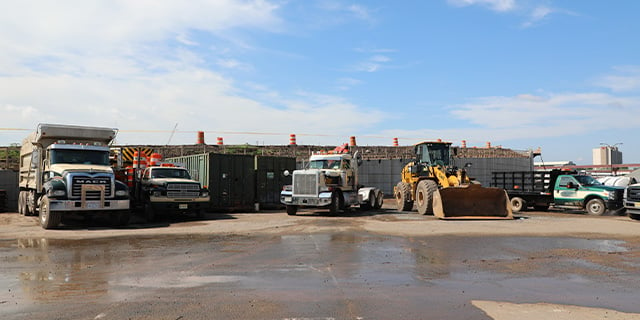
In construction businesses, the more transparency you have over your assets (people, equipment, tools), the more margin you can earn, more competitive you will be and more profit you will generate.
Equipment fleet management is economical for construction. It really effects improving logistics and operations which saves you money on active projects, assists in accurately estimating costs, prices and rates for the next job, and drives more efficient and cost-effective decision making for the business as a whole.
Equipment fleet and asset management directly effects your bottom line in four simple, but major ways:

1. Improves Productivity and Progress
Effective management of your mixed fleet allows active projects to meet their schedules and milestones. This improved performance positively impacts your internal organization and elevates your client satisfaction levels.
Giving your employees tools that make their jobs easier boosts their productivity. Reducing the amount of time your employees spend searching for assets, backtracking, making and missing phone calls and other typical inefficiencies greatly contributes to a reduction in wasted time. Eliminating these inefficiencies directly increases the amount of time employees have to get quality work done, which translates to improved productivity. Cost impacts of this are touched on in example four.
Externally, this helps you progress further in your projects faster, which improves your relationships with your clients and could lead to repeat work or reviews and accolades that contribute to the winning of new work. Read more about this in example three.
Internally, equipment management permeates throughout your organization. Used effectively, it reaches employees in all levels and departments in your business beyond just operations. Equipment fleet management software automates data flow between departments and improves communications, overall saving lots of time for all parties.
Not only does this benefit the whole team, but it improves employee attitude and motivation. Motivated and productive employees in the field and in the office are the ones your construction business benefits most from.

2. Provides Insights on Operational Efficiencies and Performance
Equipment fleet management systems provide insights on your assets that were previously unavailable or extremely difficult to back into manually. Analysis of this data can be used to drive improvements and affect change in multiple areas of your construction business.
Performance insights can keep your fleet operational with reduced downtime and elimination of inefficiencies. They can help improve your balance sheet by exposing dead-weight machines that are not working or being used but are continuing to cost you to carry that you can eliminate. Read more about this in example four.
We asked one Tenna customer we interviewed prior to implementing about how many hours they speculated their wheel loader was working on one project. Their estimate was 2,000 hours, yet the accurate hours logged were 800 hours. The remaining 60% of the time their machine was not in use was wasted. This 60% could have been used on another jobsite to eliminate an unneeded rental or purchase, saving thousands of dollars in costs on a new/stand-in asset and improving utilization on the owned asset.
Overall, equipment fleet management lowers the cost of asset ownership with better utilization and maintenance insights, and helps you better manage costs associated with project variables, including your equipment, labor and inventory.

3. Increases Competitiveness
Accurate utilization data, as touched on in the previous example, gives way to more accurate bid rates. Without accurate utilization data, you provide your estimators with inflated internal costs, which they apply to bids for projects that require similar work. This can, first, make or break a bid, and second, impacts the margin your team will make on that project.
Utilization data provided by your equipment fleet management system can help your operations and estimating teams accurately estimate how long an asset will be needed to perform an operation on a future job.
Further, as touched on in example one, when your customers see you performing efficiently on their projects, it leads to an increase in your client satisfaction rate. Happy customers lead to positive evaluations, awards and accolades to help you qualify for future RFPs and, most desirably, repeat work.
Winning more work grows your bottom line. Increasing your margins and profits with operational efficiencies and informed cost data to underpin bid rates grows that cushion even more.
Equipment management technology is becoming an industry standard. If your competitors are using it already, you are at a disadvantage. Don’t jeopardize your future win rates.

4. Reduces Capital Expenditures
Many of the topics covered in the earlier examples directly relates to a reduction in capital expenditures. Through the elimination of underutilized assets, better preventative maintenance programs that prolong and maximize an asset’s lifespan, and better visibility and accessibility of assets you already own and have available vs. need to rent, efficient asset management significantly impacts a business’ capital expenses.
With equipment resources being one of a contractor’s highest cost centers, better purchase, elimination, rental, and maintenance decisions that can be arrived at from an asset management system’s insight can save a contractor many thousands of dollars each year. With the elimination of one equipment related expense, the equipment management system typically pays for itself. And, in reality, the system eliminates many of these expenses over the course of a year.
The other high cost center for a contractor is labor. With an equipment fleet management system improving daily productivity, work can be completed more quickly and efficiently. Productivity increases while schedule and cost impacts decrease, saving contractors tons on labor costs. When productivity is improved across projects, contractors can better estimate how long it will take to perform routine operations and man hours in future bids; another bid savings and margin buffer. Combined with reduced costs, you grow the bottom line on your jobs and in your business.
Conclusion
Equipment fleet management is an investment in your business, rather than another operating expense. Not only will it bring efficiencies to your operations, but it will also bring about efficiencies in your personnel who directly benefit from what the technology can offer them in terms of less manual work, better tools to get their jobs done right, higher productivity, and improved satisfaction and performance overall. These operational and labor efficiencies (the two greatest cost centers for contractors), combined with insights that help win new work directly translates to your bottom line and the growth of your construction business.
The time to implement is now.
About Jose Cueva
As Chief Product Officer and Co-Founder, Jose applies his first-hand construction experience and knowledge to deliver innovative platform solutions to a growing number of companies. His involvement in both architecting construction-specific solutions and delivering them enables him to cross over functional roles.
